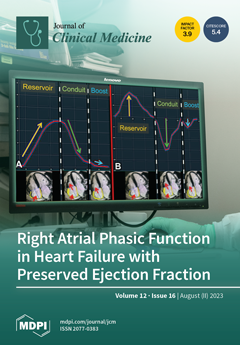Background: Persistent inflammation, immunosuppression, and catabolism syndrome (PIICS) is known as a prolonged immunodeficiency that occurs after severe infection. Few studies have demonstrated a direct relationship between PIICS and physical dysfunction in post-intensive care syndrome (PICS). We herein investigated how each component of
[...] Read more.
Background: Persistent inflammation, immunosuppression, and catabolism syndrome (PIICS) is known as a prolonged immunodeficiency that occurs after severe infection. Few studies have demonstrated a direct relationship between PIICS and physical dysfunction in post-intensive care syndrome (PICS). We herein investigated how each component of PICS was affected by the diagnosis of PIICS during hospitalization and examined the relationship between PIICS and PICS using PICS assessments performed at the Hitachi General Hospital PICS Clinic. Methods: The 273 patients who visited the PICS clinic at one month after discharge from the ICU at Hitachi General Hospital were included in the study. We used the diagnostic criteria for PIICS described in previous studies. At least two of the following blood test values on day 14 of hospitalization had to be met for a diagnosis of PIICS: C-reactive protein (CRP) > 2.0 mg/dL, albumin (Alb) < 3.0 g/dL, and lymphocytes (Lym) < 800/μL. Blood test values closest to day 14 out of 11–17 days of hospitalization were used. The primary outcome was a Barthel Index (BI) < 90, while secondary outcomes were the results of various PICS assessments, including mental and cognitive impairments, performed at the PICS clinic. We supplemented missing data with multiple imputations by chained equations. We performed a nominal logistic regression analysis with age, sex, BMI, SOFA, and the presence of PIICS as variables for BI < 90. Results: Forty-three out of two hundred seventy-three PICS outpatients met the diagnostic criteria for PIICS during hospitalization. In comparisons with non-PIICS patients, significantly higher severity scores for APACHE II and SOFA and a longer hospital stay were observed in PIICS patients, suggesting a higher clinical severity. The primary outcome, BI, was lower in the PIICS group (97.5 (58.5, 100) vs. 100 (95, 100),
p = 0.008), as were the secondary outcomes (FSS-ICU: 35 (31, 35) vs. 35 (35, 35), MRC score: 55 (50.25, 58) vs. 58 (53, 60), grip strength: 16.45 (9.2, 25.47) vs. 20.4 (15.3, 27.7)). No significant differences were noted in mental or cognitive function assessments, such as HADS, IES-R, and SMQ. A multivariable analysis supplemented with missing data revealed that PIICS (odds ratio: 1.23 (1.08–1.40
p = 0.001) and age (odds ratio: 1.007 (1.004–1.01),
p < 0.001) correlated with BI < 90, independent of clinical severity such as sequential organ failure assessment (SOFA). Similar results were obtained in the sensitivity analysis excluding missing data. Conclusions: The present study revealed a strong relationship between PIICS and post-discharge PICS physical dysfunction in patients requiring intensive care.
Full article






